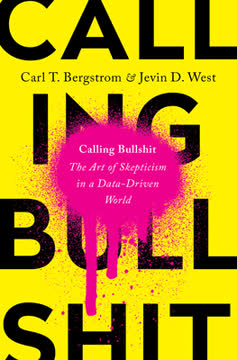Key Takeaways
1. Ubiquitous Bullshit Demands Critical Thinking
The world is awash with bullshit, and we’re drowning in it.
Defining Bullshit. Bullshit is characterized by a blatant disregard for truth, logical coherence, or what information is actually being conveyed, often intended to persuade or impress. It differs from lying, which is a deliberate attempt to deceive, as bullshitters may not even care about the truth. Bullshit can be old-school, using rhetoric and fancy language, or new-school, using math and science to create an impression of rigor.
Origins of Bullshit. Bullshit is not a modern invention, with roots tracing back to ancient sophists and even animal deception. Animals, like mantis shrimp and ravens, use deception for survival, but humans take it to the next level with language and theory of mind.
The Need for Detection. In today's world, adequate bullshit detection is essential for the survival of liberal democracy. Democracy has always relied on a critically thinking electorate, but never has this been more important than in the current age of fake news and international interference in the electoral process via propaganda disseminated over social media.
2. The Internet: Amplifier of Misinformation
The invention of new and various kinds of communication has given a voice and an audience to many people whose opinions would otherwise not be solicited, and who, in fact, have little else but verbal excrement to contribute to public issues.
Democratization and its Dark Side. The internet has democratized information, allowing marginalized voices to be heard and niche communities to form. However, this democratization has a dark side, as amateur writers can reach audiences as large as professional journalists, but often lack the training and incentives to report accurately.
Click-Driven Media. The internet news economy is driven by clicks, prioritizing sensationalism and emotional engagement over quality and accuracy. This has led to an arms race among headlines, with publishers promising emotional experiences rather than conveying facts.
Partisanship and Polarization. Online, mainstream outlets deliver news with a partisan slant, isolating people in echo chambers. Hyperpartisan news sources further distort information, and algorithms amplify content that aligns with users' sociopolitical orientations, suppressing alternative viewpoints.
3. Bullshit Obscures Truth, Not Just Falsity
Bullshit involves language, statistical figures, data graphics, and other forms of presentation intended to persuade or impress an audience by distracting, overwhelming, or intimidating them with a blatant disregard for truth, logical coherence, or what information is actually being conveyed.
Persuasion Over Truth. Bullshit is not merely about falsehood; it's about persuasion or impression management without regard for truth. The speaker aims to manipulate the listener with rhetorical flair, superfluous detail, or statistical snake oil.
The Black Box Analogy. Bullshit often functions like a "black box," shielding claims from scrutiny by using jargon, complex statistics, or sophisticated technology that most people don't understand. This makes it difficult to fact-check and challenge the claims.
Focus on Data and Results. To fight back, focus on the data that goes into the black box and the results that come out. Are the data unbiased, reasonable, and relevant? Do the results pass basic plausibility checks? Do they support the conclusions drawn?
4. Correlation Does Not Equal Causation
Falsehood flies, and truth comes limping after it.
The Trap of Causality. It is human nature to infer that when two things are associated, one causes the other. However, this is a common source of bullshit, as people often take evidence of correlation and try to sell a story about causation without sufficient evidence.
Examples of Misinterpretation. The media often misrepresents correlational studies as causal, such as claiming that exercise lowers cancer risk based on a study that only showed an association. Similarly, the "never-been-kissed" study, which found an association between self-esteem and kissing, does not prove that self-esteem causes kissing or vice versa.
The Importance of Rigorous Analysis. To avoid falling for this fallacy, it is crucial to think critically about the direction of causality, consider alternative explanations, and look for manipulative experiments that can isolate the cause-and-effect relationship.
5. Numbers Can Deceive Without Lying
The amount of energy needed to refute bullshit is an order of magnitude bigger than [that needed] to produce it.
The Illusion of Objectivity. Numbers feel objective, but they are easily manipulated to tell whatever story one desires. They can be presented without context, making it difficult to make meaningful comparisons.
Distorting the Truth. Bullshit often arises either because there are biases in the data that get fed into the black box, or because there are obvious problems with the results that come out. Quantitative evidence generally seems to carry more weight than qualitative arguments. This weight is largely undeserved—only modest skill is required to construct specious quantitative arguments.
The Power of Context. To be transparent, numbers must be placed in an appropriate context. Numbers must presented in a way that allows for fair comparisons.
6. Selection Bias Distorts Reality
The world is awash with bullshit, and we’re drowning in it.
The Problem of Non-Random Samples. Selection bias arises when the individuals sampled for a study differ systematically from the population of individuals eligible for the study. This can lead to misleading conclusions, as the sample is not representative of the larger group.
Examples of Selection Bias. Auto insurance ads that claim "average annual savings over $500" are misleading because only those who save money by switching are likely to switch. Similarly, a study of college students' kissing habits may not be representative of the broader population.
The Importance of Randomization. To avoid selection bias, it is crucial to ensure that the sample is random with respect to the question being asked. In clinical trials, randomizing treatments helps to minimize selection biases and ensure that differences in outcome are due to the treatment, not pre-existing conditions.
7. Data Visualization Can Mislead
The amount of energy needed to refute bullshit is an order of magnitude bigger than [that needed] to produce it.
The Power of Visuals. Data visualizations can help simplify complex information and highlight important ideas. However, they can also be used to distract, confuse, and mislead readers.
Common Tricks. Designers can manipulate axes, use inappropriate chart types, and violate the principle of proportional ink to create a false impression. For example, inverting the vertical axis can make a rise in homicides look like a decline.
The Importance of Critical Evaluation. To avoid being misled, it is crucial to look at the axes, understand the chart type, and consider whether the visualization accurately represents the underlying data.
8. AI and Big Data: Powerful, but Not Infallible
The world is awash with bullshit, and we’re drowning in it.
The Promise and Peril of AI. Machine learning and artificial intelligence have made remarkable progress, but they are not immune to bullshit. The algorithms are basically the same ones invented in the 1950s, and even computational power has started to level off over the past ten years.
Garbage In, Garbage Out. Machine learning algorithms are only as good as the data they are trained on. Biased or flawed training data can lead to biased or flawed results, perpetuating existing inequalities.
The Need for Scrutiny. To call bullshit on AI, it is often sufficient to ask for details about the training data and to consider whether the results are being interpreted appropriately. It is also important to be aware of the limitations of AI and to avoid overhyping its capabilities.
9. Science Is Susceptible to Bullshit
The world is awash with bullshit, and we’re drowning in it.
The Human Element. Science, while a powerful tool for understanding the world, is a human endeavor and is therefore susceptible to biases, errors, and even fraud. Scientists are motivated by curiosity, but also by recognition, funding, and career advancement.
The Replication Crisis. A significant portion of published research findings cannot be reproduced, raising concerns about the reliability of scientific results. This can be attributed to factors such as p-hacking, publication bias, and the base rate fallacy.
The Importance of Skepticism. To navigate the scientific literature, it is crucial to be skeptical, to question the source of information, and to be aware of the potential for bias and error.
10. Spotting Bullshit Requires a Critical Mindset
The world is awash with bullshit, and we’re drowning in it.
Cultivating Habits of Mind. Spotting bullshit requires cultivating appropriate habits of mind, such as questioning the source of information, being aware of unfair comparisons, and thinking in orders of magnitude. It also involves avoiding confirmation bias and considering multiple hypotheses.
The Importance of Source Evaluation. Journalists are trained to ask the following simple questions about any piece of information they encounter: Who is telling me this? How does he or she know it? What is this person trying to sell me?
The Power of Fermi Estimation. Fermi estimation is useful for more than scientific problems. The same approach provides a powerful way to think about social issues.
11. Refuting Bullshit: A Call to Action
The world is awash with bullshit, and we’re drowning in it.
Calling Bullshit as a Performative Utterance. Calling bullshit is not merely reporting disbelief; it is a public act of repudiation. As such, it should be done responsibly, appropriately, and respectfully.
Strategies for Refutation. Effective refutation involves using reductio ad absurdum, finding counterexamples, providing analogies, redrawing figures, and deploying null models. It also requires being clear, pertinent, and charitable.
The Importance of Ethical Engagement. Calling bullshit is crucial to the healthy functioning of a social group, but it should be done with humility, respect, and a focus on the argument, not the person.
Last updated:
FAQ
What's Calling Bullshit: The Art of Skepticism in a Data-Driven World about?
- Focus on Misinformation: The book explores how misinformation spreads in a data-driven world, particularly through social media and data visualization.
- Critical Thinking Skills: Authors Carl T. Bergstrom and Jevin D. West aim to equip readers with tools to critically analyze quantitative arguments and recognize manipulation.
- Democracy and Bullshit: It argues that detecting and refuting misinformation is crucial for the survival of liberal democracy, especially in the age of fake news.
Why should I read Calling Bullshit: The Art of Skepticism in a Data-Driven World?
- Empowerment Through Knowledge: The book empowers readers to think critically about daily information, helping to discern fact from fiction.
- Engaging and Accessible: Complex ideas are presented in an engaging manner, using humor and relatable examples to illustrate key concepts.
- Civic Responsibility: It emphasizes the importance of being an informed citizen, relevant for anyone concerned about public discourse.
What are the key takeaways of Calling Bullshit: The Art of Skepticism in a Data-Driven World?
- Understanding Bullshit: Bullshit is defined as presentations intended to persuade or impress by distracting or overwhelming with a disregard for truth.
- Causation vs. Correlation: The book warns against assuming causation from correlation without sufficient evidence.
- Data Visualization Awareness: Readers learn to critically evaluate data visualizations, recognizing misleading design choices.
What are the best quotes from Calling Bullshit: The Art of Skepticism in a Data-Driven World and what do they mean?
- Energy to Refute Bullshit: "The amount of energy needed to refute bullshit is an order of magnitude bigger than [that needed] to produce it." This highlights the challenge of combating misinformation.
- Bullshit Defined: "Bullshit involves language, statistical figures, data graphics, and other forms of presentation intended to persuade or impress an audience." It emphasizes manipulation over falsehoods.
- Goodhart's Law: "When a measure becomes a target, it ceases to be a good measure." This reflects how metrics can be gamed when they become the focus of evaluation.
How does Calling Bullshit: The Art of Skepticism in a Data-Driven World address data visualization?
- Critical Evaluation of Graphs: The authors discuss how data visualizations can mislead by manipulating axes or using inappropriate scales.
- Importance of Context: Numbers must be presented in context to be meaningful, as raw figures can obscure important comparisons.
- Design Choices Matter: The design of a graph can significantly influence data perception, urging vigilance about graphical representations.
What is the difference between correlation and causation in Calling Bullshit: The Art of Skepticism in a Data-Driven World?
- Definition of Correlation: Correlation is a statistical relationship between two variables, but it does not imply causation.
- Causation Explained: Causation means one event is the result of another, directly affecting the other variable.
- Common Misunderstanding: The book warns against assuming causation from correlation, emphasizing the need for rigorous evidence.
What specific methods does Calling Bullshit: The Art of Skepticism in a Data-Driven World suggest for spotting misinformation?
- Corroborate and Triangulate: Check multiple sources to verify surprising claims, treating uncorroborated information with skepticism.
- Use Reverse Image Lookup: Verify image authenticity using reverse image search tools to identify manipulated images.
- Consider Multiple Hypotheses: Evaluate claims by considering various explanations, avoiding confirmation bias.
What is the principle of proportional ink mentioned in Calling Bullshit: The Art of Skepticism in a Data-Driven World?
- Definition of Proportional Ink: The size of shaded areas in a graph should be proportional to the values they represent.
- Importance in Data Visualization: Violating this principle can lead to misleading interpretations of data.
- Application in Graphs: Examples from sports and economic data show how improper scaling can mislead audiences.
What is the concept of "selection bias" in Calling Bullshit: The Art of Skepticism in a Data-Driven World?
- Definition of Selection Bias: It occurs when a study's sample is not representative of the population, leading to skewed results.
- Impact on Research: Selection bias can distort findings, as seen in surveys and studies with unrepresentative samples.
- Real-World Implications: Understanding selection bias is crucial for accurately interpreting research and trends.
How does Calling Bullshit: The Art of Skepticism in a Data-Driven World relate to democracy?
- Critical Electorate: A functioning democracy relies on a critically thinking electorate that can discern truth from misinformation.
- Impact of Misinformation: Misinformation can undermine public trust and distort democratic processes.
- Civic Responsibility: The book calls for individuals to take responsibility for their information consumption, advocating for informed citizenry.
What is the significance of the "prosecutor's fallacy" discussed in Calling Bullshit: The Art of Skepticism in a Data-Driven World?
- Understanding Conditional Probabilities: It illustrates confusion between the likelihood of a match given innocence and innocence given a match.
- Implications for Scientific Claims: Parallels are drawn with p-values in research, highlighting potential misinterpretations.
- Critical Thinking Application: Recognizing this fallacy encourages careful consideration of statistical claims.
How can I apply the lessons from Calling Bullshit: The Art of Skepticism in a Data-Driven World in my daily life?
- Develop Critical Habits: Question the sources of information, considering motivations and evidence.
- Practice Fermi Estimation: Use rough estimates to evaluate the plausibility of numerical claims.
- Engage in Discussions: Consider multiple perspectives and hypotheses to foster open dialogue and informed conclusions.
Review Summary
Calling Bullshit receives mostly positive reviews for its accessible approach to critical thinking and spotting misinformation. Readers appreciate its timely content, practical examples, and humor. Many find it useful for navigating today's information-heavy world. Some criticize its density or repetitiveness, while others praise its thoroughness. The book is often recommended as essential reading for students and adults alike. Reviewers highlight its insights on data manipulation, scientific publishing, and social media. Overall, it's seen as a valuable guide for developing skepticism in a data-driven society.
Similar Books
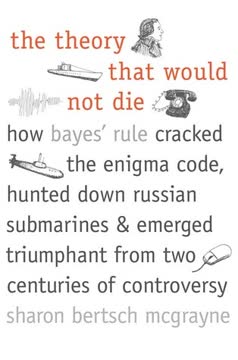
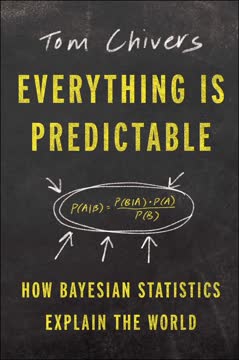
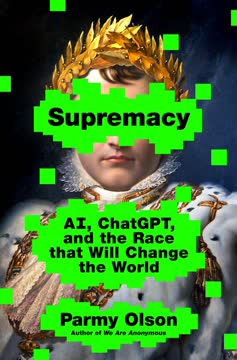


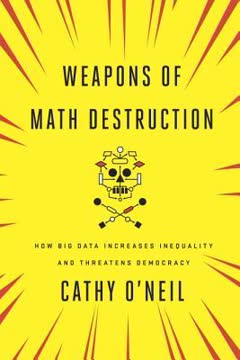

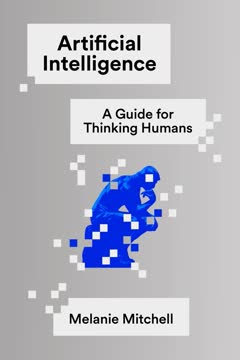
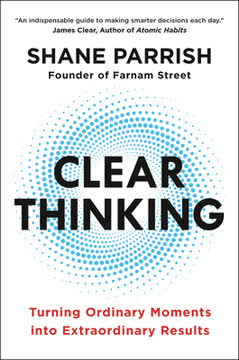
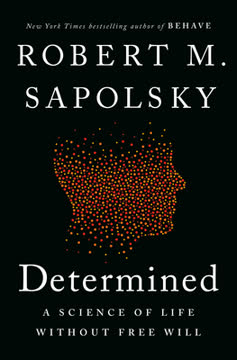
Download PDF
Download EPUB
.epub digital book format is ideal for reading ebooks on phones, tablets, and e-readers.
